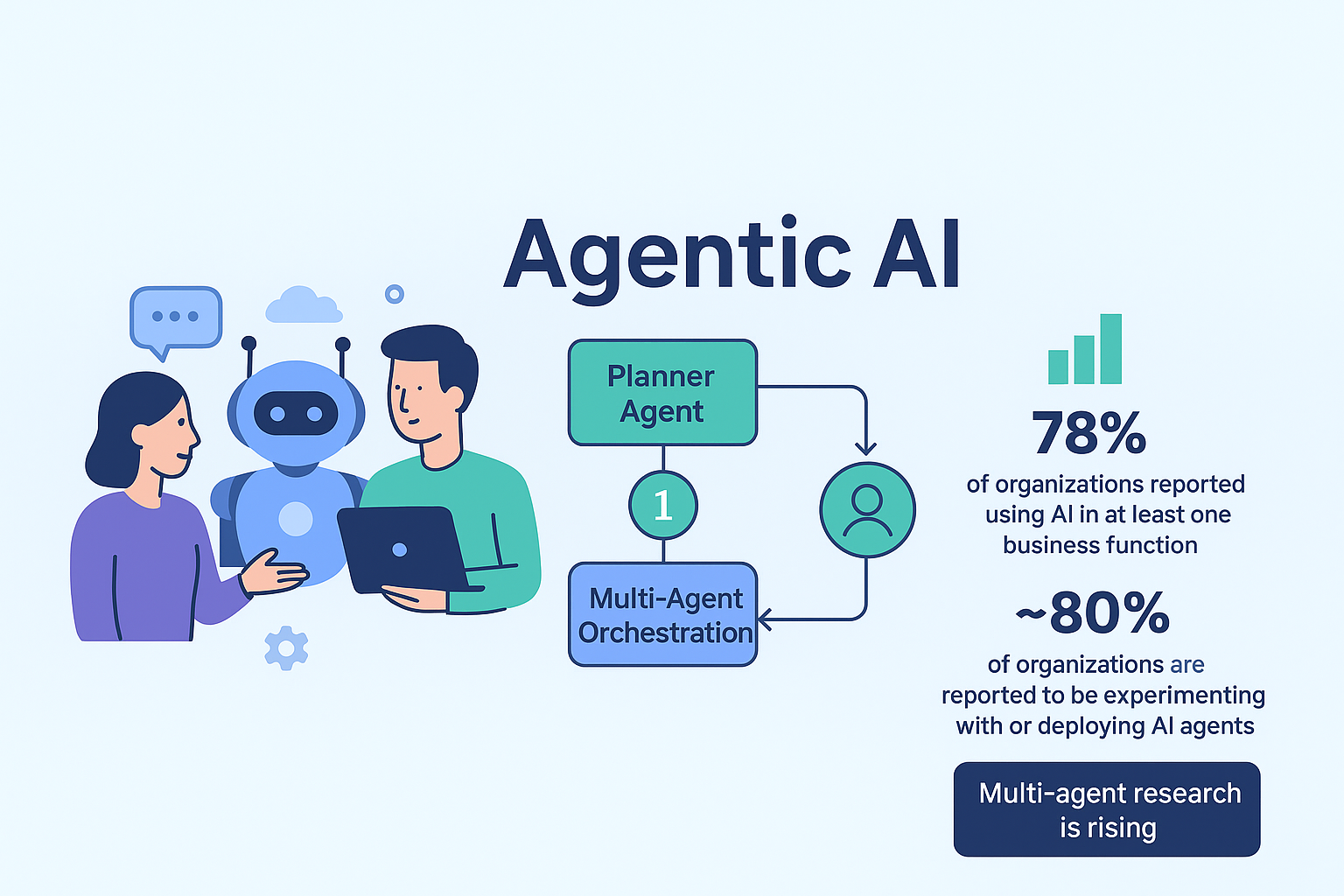The Age of Agents
Agentic AI: What it Is, Why It Matters, and Where It’s Headed
Agentic AI: What it Is, Why It Matters, and Where It’s Headed
A practical, research-informed guide explaining agentic AI, real-world examples, adoption stats, risks, and how teams should prepare.
Outline
- Intro: plain-language definition
- Short history & how agentic differs from earlier AI
- Core capabilities & architecture patterns
- Top use cases and real-world examples
- Key statistics & adoption signals
- Risks, failure modes, and governance
- Practical playbook for teams
- Conclusion and further reading
1. Intro — What is Agentic AI?
Put simply: agentic AI describes systems (or collections of systems) that accept high-level goals from humans and operate autonomously to achieve them — planning, taking actions, coordinating with tools and other agents, and adapting when things change. Agentic systems move beyond narrow “query → response” assistants and act like persistent, goal-oriented collaborators.
Definition and examples derived from cloud-provider and industry explainers. :contentReference[oaicite:0]{index=0}
2. A short history — how agentic differs from earlier AI
Generative AI (ChatGPT-style models) popularized natural language interfaces and content creation. Agentic AI builds on that progress but adds: planning loops, memory/persistence, tool use (APIs, web, databases), and multi-step decision making without constant human micro-instructions. Academic surveys now distinguish “AI agents” (task-specific tool-using bots) from broader agentic systems that orchestrate multi-agent workflows and persistent goals. :contentReference[oaicite:1]{index=1}
3. Core capabilities & architecture patterns
- Goal decomposition: breaking a high-level objective into ordered subtasks.
- Tool integration: calling APIs, using a browser, reading/writing databases, or triggering workflows.
- Memory & state: persistent context to remember past outcomes and preferences.
- Multi-agent orchestration: specialists collaborate—planner agents, analyzer agents, and executor agents.
- Observation & re-planning: monitoring results and adjusting plans when assumptions fail.
Patterns summarized from taxonomy and industry architecture guides. :contentReference[oaicite:2]{index=2}
4. Use cases & real-world examples
Agentic AI is already showing traction across many domains:
- Enterprise ops: automated ticket triage, schedule reshuffling, vendor coordination.
- Customer experience: end-to-end problem resolution — e.g., booking travel, cancelling & rebooking when flights change.
- Sales & GTM: persistent lead-nurturing agents that research accounts and suggest actions.
- Research automation: literatures review, experiment planning, and result aggregation.
- Robotics & control: coordination layers for multi-robot tasks (warehouse logistics, drones).
Major travel platforms and enterprises are already exploring agentic features that can autonomously plan trips and book services, signaling early industry adoption. :contentReference[oaicite:3]{index=3}
5. Quick stats — the adoption signals you should track
78% of organizations reported using AI in at least one business function (broad AI, 2024→2025 trend).
Source: global State of AI survey. :contentReference[oaicite:4]{index=4}
~80% of organizations are reported to be experimenting with or deploying AI agents, with strong growth expectations into 2025.
Industry adoption snapshot. :contentReference[oaicite:5]{index=5}
Multi-agent research is rising: recent academic taxonomies formalize the boundary between one-shot agents and persistent agentic systems, highlighting coordination and governance as top challenges.
Academic taxonomy and roadmap. :contentReference[oaicite:6]{index=6}
Note: published percentages vary by survey and definition. But everywhere you look, the trend is the same — rapid experimentation and growing bets on agentic capabilities.
6. Risks, failure modes, and governance
Agentic systems amplify many existing AI risks and create some new ones:
- Actionable hallucinations: when an agent confidently executes an incorrect action (e.g., sending incorrect invoices).
- Overreach & scope creep: agents can expand behaviors beyond intended bounds unless constrained.
- Coordination failures: multiple agents disagree or deadlock on a plan.
- Security & privacy: tools that call external APIs or act on real systems require strict access controls.
- Governance & auditability: teams need observable decision traces, versioned policies, and human-in-the-loop checkpoints for high-risk tasks.
Research and industry leaders stress orchestration, observability, and governance as top priorities. :contentReference[oaicite:7]{index=7}
7. Practical playbook — how teams should start
Start small, learn fast, and instrument everything. Here's a compact playbook:
- Pick a bounded domain: choose an area with clear success metrics (e.g., scheduling, expense triage).
- Design guardrails: require confirmations for high-risk actions and define an explicit rejection policy.
- Build an orchestrator: a lightweight control plane that sequences sub-agents, logs decisions, and enforces rate limits and permissions.
- Measure end-to-end outcomes: track accuracy, task completion, time saved, and unexpected side effects.
- Human oversight: humans in the loop for edge cases; human on-call for escalation.
- Policy & auditing: version policies, retain decision logs, and implement privacy controls before scaling.
Guidance adapted from industry architecture and governance papers. :contentReference[oaicite:8]{index=8}
8. Conclusion — the near-term horizon
Agentic AI is not a single product — it’s an engineering pattern and a new collaboration model between humans and software. Over the next 1–3 years we’ll see agentic features embedded into vertical SaaS offerings (travel, HR, customer support), internal automation, and research tooling. The upside is big — dramatic productivity gains and new classes of automation — but so are the governance needs. Teams that pair fast experimentation with strong observability and human oversight will capture the most value while managing the risks.
Industry momentum and research perspectives summarized from major publications. :contentReference[oaicite:9]{index=9}
Further reading & sources
- McKinsey — The State of AI (enterprise adoption & trends). :contentReference[oaicite:10]{index=10}
- ArXiv taxonomy — "AI Agents vs. Agentic AI" (research taxonomy and challenges). :contentReference[oaicite:11]{index=11}
- AWS explainer — what is agentic AI (provider viewpoint and examples). :contentReference[oaicite:12]{index=12}
- Financial Times — agents in travel industry (real-world industry example). :contentReference[oaicite:13]{index=13}
- Industry stats roundup — agentic AI adoption signals and forecasts. :contentReference[oaicite:14]{index=14}
Written for technical leaders and curious builders — feel free to adapt this draft for newsletters, internal docs, or a longer whitepaper.
If you'd like, I can: (a) convert this into a shorter executive brief, (b) produce a slide deck from the same content, or (c) create a code checklist for building a safe agentic prototype.
Popular posts

Artificial Intelligence
The Age of Agents

